Daybreak: Bagan and Mandalay, Myanmar
- mkap23
- Dec 28, 2019
- 8 min read
Bagan
At four o’clock in the morning, Bagan is quiet and empty. We know this because that’s when we arrived, coming off the overnight bus from Inle Lake. But, that would quickly change just one hour later.
Since we were already awake (barely), we decided to go watch the sunrise over the famous Bagan temples—a popular activity, but one we probably wouldn’t have attempted under normal circumstances. We were the second and third people to arrive at the guidebook-recommended, man-made hill near Sulamani temple, which boasts a good view of Bagan’s Central Plain and its many temples, their structures coming into view as blurry shadows and then taking shape as the sun begins to rise. We found a premium spot in the quiet darkness, and then hung around for awhile, waiting for light. Then, to our dismay, at about 5:30am, a massive tour bus rolled up. Then another, and then another. The silence was abruptly broken by the 200 or so people who scampered up the hill, chatting loudly and swarming the viewing platform. As soon as they arrived, sales vendors popped out of nowhere to hawk postcards and keychains. We half expected this, given how easy it was to access this hill and how widely published it was, so at first, we held our ground despite needing to jockey for position. But when Karen kept getting nudged off the railing, we decided it was time to go.

Just as dawn broke over the horizon, we left to try our luck somewhere else. We wandered around the beautiful Sulamani and Tha Beik temples right after their gates opened, which were incredibly peaceful with no one else around, but we couldn’t get much of a view there. Then, around the bend, we noticed a few motorbikes parked near a clearing and a pathway up to another small hill. Climbing up, we were treated to a spectacular view of temple pyramids and stupa spires rising above the fields as the day’s light began to flood the plains. It was an even better view than our first location, and with only a fraction of the people. From behind us, a stream of hot air balloons came sweeping over the field—the payoff for the early morning start. It looked like the magical balloon scenes from Cappadocia (though we have never been, so we’re just going off photos). As the sky filled with hot air balloons floating above the temples, we felt our initial annoyance and fatigue also drift away with them. Bagan is very touristy and busy—Myanmar’s most visited location—but if you venture off the beaten path even just a little bit, it truly is a gem. This would prove to be true over our next few days here.

The ancient city of Bagan was founded by the Burmese King Anawratha in the 11th century. The region was previously Hindu, but the king converted to Buddhism and was so enamored by his newfound faith that he decided to build a new capital to honor it on the flat banks of the Irrawaddy River. And build he did!—some 4,000 red brick temples were constructed by King Anawratha and his successors between the 11th and 13th centuries, stopping only when Kublai Khan invaded in 1287. Despite the end of temple construction at that time, scholars today believe that it was not the Mongols who ended Bagan’s run, as there is evidence of continued civilization there through the 14th century; rather, they believe that it was the constant fighting between the Burmese and the neighboring Shan and Mon people that brought the kingdom down—the same conflict that still happens in Myanmar today.
Though the ancient civilization ultimately faltered, Bagan’s splendor (and productivity!) is memorialized in the thousands of spectacular temples that still stand today. We had been looking forward to visiting this lost kingdom for quite some time. It came onto our radar in 2014, after we visited Borobudur in Indonesia during our honeymoon. Borobudur is part of the “Big Three” ancient Buddhist sites, along with Bagan and Angkor Wat (though Angkor Wat was originally constructed as a Hindu temple); because we thought Borobudur was so amazing, we were immediately intrigued by the other two, as well. With so much anticipation built up over the years, it was exciting for us to finally get to explore these storied temples across the vast, sun-drenched plains, and even more exciting to do it on an “e-bike,” or an electronic motorbike, which is the vehicle of choice across Bagan. Similar to Hpa-an, Bagan’s dirt paths and enclosed footprint made for another ideal motorbike setting. Scooting around, we were able to easily access more remote regions of the park, where we often found ourselves frolicking around crumbled ruins and interpreting detailed wall frescos all by ourselves—all while being environmentally friendly!

The temples themselves are in varying degrees of condition today. There are still many unrestored buildings and piles of rubble, but at least 1,300 have been “restored.” “Restored” in quotes, because the international preservation community is up in arms over some of the inaccuracies and shoddy workmanship of the restoration. Much of this critique is now moot, as many of the temples were heavily damaged in a large earthquake in 2016. Because of the instability of many of the temples after the earthquake—and in order to get in good graces with UNESCO to get Bagan on its prestigious World Heritage list—visitors are no longer allowed to climb up onto the various levels of the temples anymore. As a visitor, this is a somewhat unfortunate change, since it pushes the masses to only a few available vantage points for the much-desired expansive view of the temple-studded plain (Exhibit 1: aforementioned sunrise), but of course, it is also completely understandable for the long-term preservation of the site.
Despite the crowds, the recent damages, and the questionable renovations, Bagan is still an unquestionably awesome sight to behold. Driving around the park on empty roads, temple after temple just keep popping up; many are simply named “Temple #895” because there are just too many to name. And these are not just simple small structures; almost all of them are much larger and more intricately designed than we had expected. We started out by stopping at every one because each one was so magnificent and unique, but after awhile, we had seen our fair share of Buddha statues.
As a good reminder for life in general, it was almost when we stopped going into each temple and just drove around leisurely that we realized the true beauty of this place: the awe of Bagan is not in each individual temple (even though they are amazing), but rather, in the sheer scope and scale of it all. The sense of seeing the silhouettes of endless corn-cob hti (the name for the pinnacle that sits atop most of the temples), stretching all the way toward the horizon, peeking out from layers of humidity and grasslands, is enough to make you feel small in the same way a towering mountain pass does.
We were also in Bagan while it was still the long holiday weekend celebrating the Tazaungmone full moon, or the end of the rainy season (which we started celebrating in Taunggyi), which meant that we shared the temples with as many locals (if not more) as Western tourists, coming to pray and to honor monks during Kathina, the largest alms-offering of the year. This celebration was particularly pronounced at the large, sparkling Ananda Pahto, which was packed to the brim with Myanmar visitors, and at Shwezigon Pagoda, where monks from all over Myanmar came to accept new robes and offerings in a solemn festival, and where Michael got strong-armed to donate to the temple!
After three days, we were fully templed out like a Reform Jew after the high holidays, so we made our way from the beautiful ruins, locally-made lacquer souvenirs, and international cuisine of Bagan (indeed, we ate Indian food, pizza, and even delicious vegan in Bagan!) to Mandalay, our final stop in Myanmar.
Mandalay

Having taken our fair share of buses around the country, we decided to get to Mandalay via a boat up the placid Irrawaddy River. We started before sunrise (again!), this time able to see a splendid moonset over the river before an equally gorgeous sunrise on the water. The 12-hour ride was slow but peaceful, passing through mostly flat rural areas of rice fields and grazing cows. Throughout the day, the sixteen or so of us on board had taken turns sitting in every single uncomfortable wicker chair, alternating between the side with the harsh direct sun and the side with the strong gusts of wind that tangled your hair. We napped, we read, we ate, we watched the world go by and then napped again; one guy drank what seemed like two gallons of beer by himself. Toward the end of the ride as we approached Mandalay, we passed the historic city of Sagaing, greeting us with its many stunning stupas dotting the hillside and glistening in the late afternoon light.
Mandalay brought us full circle back to where we started in Myanmar. The hot, smelly, congested city is basically another version of Yangon—with seemingly more stray dogs and a massive palace in the middle of it (which made it take much longer to cross the city than you think it should take, since you cannot cut across the palace grounds and have to circumnavigate its perimeters using limited through-roads each time). We did spend one whole day visiting a few beautiful temples, including several unique ones on top of Mandalay Hill that involved hiking up 1,729 mountain steps to the summit (which feels like 100,000 steps in the sticky hot humidity). Otherwise, we focused most of our time in Mandalay indoors in the comfort of air conditioning and finished our long-overdue Central Asian blogs.

Just as we were writing about our last night in Central Asia, which featured a hockey game in Tashkent, our last night in Myanmar was similarly capped with another sporting event. Coincidentally, Myanmar was playing Tajikistan, a Central Asian nation, in a FIFA World Cup qualifying match. We had previously tried to go to the Uzbekistan vs. Yemen qualifying game in Tashkent, but we got sick, so we were excited to be able to catch this game in Mandalay. Myanmar was strong on offense, but didn’t seem interested in playing defense, so it was a high scoring affair. Tajikistan scored a few of their goals on wide open headers off of corners; it took us a bit to realize that the Myanmar players had a hard time getting up to defend the cross because they were all really short! Myanmar ended up winning 4-3, and though they are unlikely to qualify for the 2022 World Cup, their fans were very happy, and we were also happy to enjoy the local experience at only $2 a ticket (with open seating, so we got up close).
So many things from the game were the perfect ode to our three weeks traveling through Myanmar. When we first arrived at the stadium, we couldn’t figure out where to buy tickets, missing the first few minutes and the first Myanmar goal of the game because we were aimlessly walking around and following wrong instructions; ultimately, we were directed to a scalper outside the gate— by a few military guards using their large guns and large smiles. Concessions inside the stadium consisted of literally just water poured into small, open plastic bags with a straw sticking out of them. Crowds would go wild right after a Myanmar goal—for about 60 seconds, and then quickly fall calm again, an excited but measured reaction that we had come to notice. And when we both wanted to buy Myanmar soccer swag to show our support, we couldn’t find the street vendor anymore, but then a hospitable local stranger insisted that he give us his and his friend’s headbands, which we gratefully accepted. The only thing missing was a power outage in the middle of the game, but maybe the crowd would not have even noticed, as they often paid more attention to their phones, which leveraged the country’s fabulous 4G data coverage. From its bustling cities and karst mountains, to its peaceful temples and agricultural fields, Myanmar showed us what it’s like to experience the simultaneous excitement, and uncertainty, of coming out of the dark.
Karen & Michael
Bagan and Mandalay, Myanmar, November 10-15, 2019
(click through for the slideshow below)














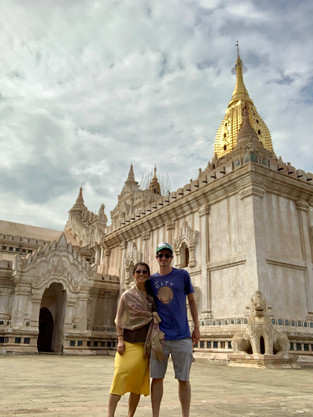











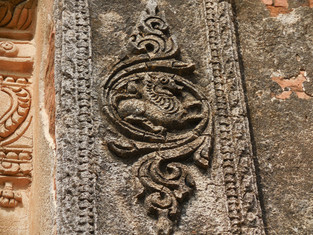





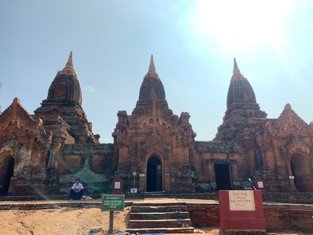









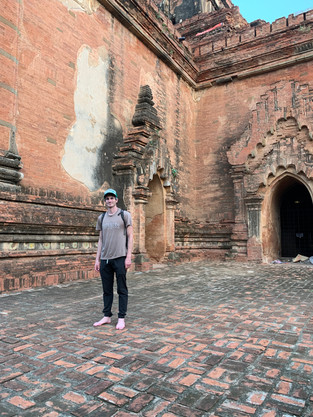




























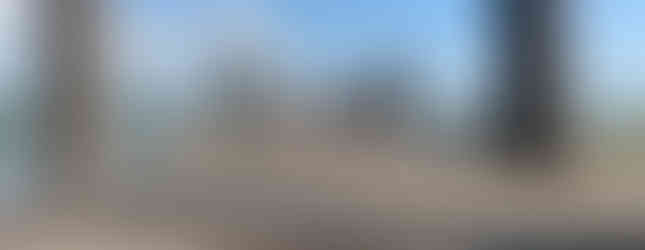




Comments